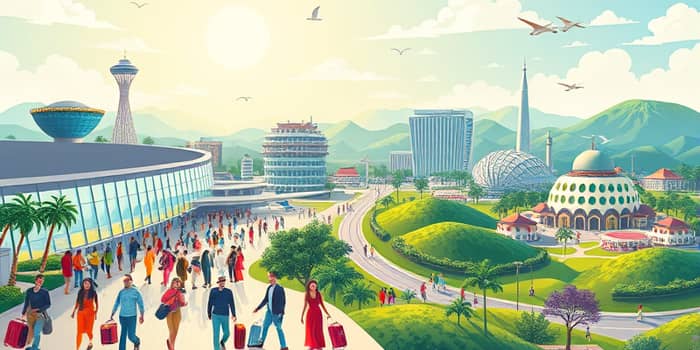
The past few years have tested resilience across every industry, yet few sectors illustrate recovery as vividly as travel and hospitality. After extended restrictions and global uncertainty, the world is rediscovering its passion for exploration. The sector’s dramatic upswing offers lessons in adaptability, innovation, and the enduring human desire for connection.
From soaring hotel occupancy to record international arrivals, the metrics confirm a powerful resurgence. Industry leaders now face the challenge of sustaining momentum while meeting evolving guest expectations. This article dives into the data, trends, and strategies shaping today’s vibrant landscape.
At the heart of this recovery lies global hotel occupancy rates have rebounded to 72% in 2025, surpassing 2019 levels by eight percentage points. Equally impressive, Revenue Per Available Room has increased 15% year-over-year, reaching $112.50. These gains underscore broad-based demand from leisure and corporate travelers alike.
The industry’s global GDP impact swelled to a record $11.1 trillion in 2024, accounting for 10% of world GDP, while the overall hospitality market size hit $4.9 trillion. International tourism volumes climbed to 1.1 billion travelers through September 2024, an 11% rise over the prior year. Such numbers reflect not only pent-up demand but also accelerating growth forecasts: travel and tourism is projected to expand at 5.8% annually from 2022 to 2032, more than double global GDP growth.
Different segments have rebounded at varied paces, revealing both opportunities and targeted focus areas:
Regional snapshots further illustrate the mosaic of recovery. In the United States, occupancy is expected to reach 63.38% in 2025—just 2.4 points shy of pre-pandemic levels—but rising operating costs are squeezing margins. Europe benefits from robust intra-regional flows despite geopolitical headwinds, while Asia-Pacific markets anticipate arrivals exceeding 2019 by 2.6% in 2025. The Middle East posted double-digit year-over-year growth, with Dubai up 9% and Abu Dhabi surging 26%. Northern Latin America also saw gains, led by Mexico (+7%), Costa Rica (+13%), and Colombia welcoming 6 million tourists in the past year.
Today’s travelers demand more than a clean room and reliable Wi-Fi. They expect personalized journeys, frictionless digital touchpoints, and a genuine commitment to sustainability. Hospitality brands are responding by integrating advanced analytics and AI to tailor recommendations, while mobile apps handle everything from contactless check-in to in-room controls.
Despite surging demand, the sector contends with significant hurdles. Approximately 68% of hotels report staffing shortages, with housekeeping roles facing 42% vacancy and culinary positions at 39%. These gaps strain service quality and operational resilience. Meanwhile, operating costs are frequently outpacing revenue growth, putting pressure on profitability.
Sustainability investments—though vital for long-term viability—require capital and expertise. Balancing eco-friendly upgrades with immediate return expectations tests leadership teams. In parallel, cybersecurity and data privacy emerge as critical areas as digital transformation accelerates.
To navigate constraints and seize opportunities, hospitality operators are embracing innovation at every level. Automation streamlines housekeeping, while robotics assist with luggage handling and sanitation. Augmented reality and virtual tours enhance pre-trip planning, keeping engagement high from the moment a guest researches options.
In the boardroom, strategic expansion is evolving. While overall M&A activity has cooled, large operators pursue targeted acquisitions in high-growth regions and niche segments. Joint ventures with wellness brands, co-branding with tech platforms, and franchising models are reshaping portfolios. These approaches aim to unlock new revenue streams and build resilience against economic fluctuations.
Future growth hinges on navigating geopolitical uncertainties, fluctuating energy costs, and evolving traveler preferences. Airlines expanding routes and maintaining low fares will remain catalysts, though fuel price volatility poses risks. Government policies, like the UK’s £19 million tourism recovery investment, demonstrate how public-private partnerships can accelerate infrastructure upgrades and marketing campaigns.
Projected annual growth of 5.8% for travel and tourism suggests the sector will outpace many global industries. As operators refine their digital, sustainability, and talent strategies, the emphasis will shift from mere recovery to purposeful expansion and enhanced guest engagement.
The travel and hospitality industry’s return to, and surpassing of, pre-pandemic benchmarks is a testament to human resilience and the timeless allure of exploration. While challenges endure—labor gaps, cost pressures, and shifting guest demands—innovation and strategic agility are paving the way forward.
As borders reopen and travelers resume their journeys, the sector stands at a pivotal juncture. By embracing personalization, sustainability, and smart technology, travel and hospitality can deliver richer experiences, foster global connections, and drive lasting economic impact.
References













